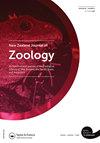Conservation history hung on a thread: the unlikely chain of events deciding New Zealand’s importation of stoats and weasels, 1880–1892
IF 1.1
4区 生物学
Q3 ZOOLOGY
引用次数: 0
Abstract
ABSTRACT The history of the introduction of stoats (Mustela erminea) and weasels (M. nivalis) to New Zealand is a paradigm example of how the course of history can turn on a sequence of simple, unconnected events. When Victorian pastoralists were faced with the dilemma that rabbits (Oryctolagus cuniculus) were thriving better than their sheep, they sought to enlist the rabbits’ natural enemies to save them from crippling economic losses. An improbable series of circumstances linked four principal characters whose dramatic anti-rabbit policies seemed reasonable to them but have had catastrophic consequences. A Lincolnshire farmer, Samuel Grant, visiting New Zealand in 1880, met Francis Rich, a pastoralist suffering rabbit damage; Rich and Grant organised a trial shipment of stoats and weasels escorted by Lincolnshire trapper Walter Allbones in 1883. Supervising Rabbit Inspector Benjamin Bayly authorised thousands more over 1884–1889, until imports stopped in 1892. This paper describes why only the four principal players could have made each necessary link in the chain, and how easily it could have been broken. Legal attempts to stop the importations failed in 1876, but within another 25 years, the ‘natural enemies’ policy was recognised as a tragic mistake, and its proponents were widely discredited.保护历史悬而未决:1880年至1892年,决定新西兰进口白鼬和黄鼠狼的不太可能的一连串事件
摘要鼬(Mustela erminea)和鼬(M.nivalis)引入新西兰的历史是一个典型的例子,说明了历史进程如何开启一系列简单、不相关的事件。当维多利亚时代的牧民面临兔子(Oryctolagus cuniculus)比绵羊更兴旺的困境时,他们试图招募兔子的天敌,使其免受严重的经济损失。一系列不太可能的情况将四个主要人物联系在一起,他们戏剧性的反兔政策对他们来说似乎是合理的,但却产生了灾难性的后果。1880年,林肯郡农民塞缪尔·格兰特访问新西兰,遇到了遭受兔子伤害的牧民弗朗西斯·里奇;1883年,Rich和Grant在林肯郡猎人Walter Allbones的护送下组织了一次白鼬和黄鼠狼的试运。监督兔子检查员Benjamin Bayly在1884年至1889年期间授权了数千只兔子,直到1892年进口停止。本文描述了为什么只有四个主要参与者才能完成链条中的每一个必要环节,以及它是多么容易被打破。1876年,阻止进口的法律尝试失败了,但在接下来的25年里,“天敌”政策被认为是一个悲剧性的错误,其支持者也广受质疑。
本文章由计算机程序翻译,如有差异,请以英文原文为准。
求助全文
约1分钟内获得全文
求助全文
来源期刊
CiteScore
2.80
自引率
0.00%
发文量
20
审稿时长
>12 weeks
期刊介绍:
Aims: The diversity of the fauna of the southern continents and oceans is of worldwide interest to researchers in universities, museums, and other centres. The New Zealand Journal of Zoology plays an important role in disseminating information on field-based, experimental, and theoretical research on the zoology of the region.

 求助内容:
求助内容: 应助结果提醒方式:
应助结果提醒方式:


